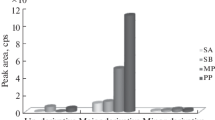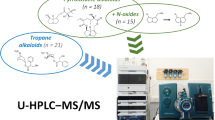Abstract
A comprehensive analytical method based on ultra-performance liquid chromatography coupled with tandem mass spectrometry (UPLC-MS/MS) has been developed for the simultaneous determination of 22 regulated coumarin derivatives in cosmetics. Various categories of cosmetic samples (creams, lotions, shampoos, and lipsticks) were subjected to optimized ultrasound-assisted extraction and solid-phase extraction procedures, which enabled exhaustive extraction of target analytes and efficient cleanup of sample matrices prior to instrumental analysis. The rapid chromatographic separation of the 22 coumarin derivatives was performed on a sub-2 µm Waters ACQUITY UPLC BEH C18 column (50 mm × 2.1 mm, 1.7 µm), preceded by a pre-column of the same packing material within 5 min. The entire column eluent from UPLC was directed into a triple quadrupole mass spectrometer with an electrospray ionization source. The MS/MS data acquisition was conducted under the mode of multiple reaction monitoring (MRM) with two precursor-product ion transitions recorded but only one used for quantitation. The proposed method was validated in terms of matrix effects, linearity, sensitivity, accuracy, precision, specificity, and stability, and could be applied for the screening and monitoring of these prohibited or restricted coumarin derivatives in cosmetics to ensure consumers’ health and protection.



Similar content being viewed by others
References
Cosmetics Europe Activity Report 2013. https://www.cosmeticseurope.eu/publications-cosmetics-europe-association/annual-reports.html
Scientific Committee on Consumer Safety (SCCS) opinion on fragrance allergens in cosmetic products. http://ec.europa.eu/health/scientific_committees/consumer_safety/docs/sccs_o_102.pdf
Mabry TJ, Ulubelen A (1980) J Agric Food Chem 28:188–196
Oodyke DL (1974) Food Cosmet Toxicol 12:385–405
Pan TL, Wang PW, Aljuffali IA, Leu YL, Hung YY, Fang JY (2014) Toxicol Lett 226:173–181
Cohen AJ (1979) Food Cosmet Toxicol 17:277–289
Chouchi D, Barth D (1994) J Chromatogr A 672:177–183
Witaicenis A, Seito LN Jr, da Silveira Chagas A, de Almeida LD, Luchini AC, Rodrigues-Orsi P, Cestari SH, Di Stasi LC (2014) Phytomedicine 21:240–246
Żamojć K, Wiczk W, Zaborowski B, Jacewicz D, Chmurzyński L (2014) J Fluoresc 24:713–718
Wang B, Liu X, Zhou A, Meng M, Li Q (2014) Anal Methods 6:7996–8002
Patil PO, Bari SB, Firke SD, Deshmukh PK, Donda ST, Patil DA (2013) Bioorg Med Chem 21:2434–2450
Anand P, Singh B, Singh N (2012) Bioorg Med Chem 20:1175–1180
Musa MA, Cooperwood JS, Khan MO (2008) Curr Med Chem 15:2664–2679
Mielke H, Abraham K, Götz M, Vieth B, Lampen A, Luch A, Gundert-Remy U (2011) Toxicol Lett 202:100–110
Lake BG (1999) Food Chem Toxicol 37:423–453
Regulation (EC) No. 1223/2009 of the European Parliament and of the Council of 20 November 2009 on cosmetic products. http://eur-lex.europa.eu/LexUriServ/LexUriServ.do?uri=OJ:L:2009:342:0059:0209:en:PDF
Agreement of the ASEAN harmonized cosmetic regulatory scheme. http://www.asean.org/images/archive/20707.pdf
Hygienic standard for cosmetics. Ministry of Health of the People’s Republic of China. http://www.gov.cn/zwgk/2007-01/26/content_508651.htm
Directive 2003/15/EC of the European Parliament and of the Council of 27 February 2003 amending Council Directive 76/768/EEC on the approximation of the laws of the Member States relating to cosmetic products. http://eur-lex.europa.eu/LexUriServ/LexUriServ.do?uri=OJ:L:2003:066:0026:0035:en:PDF
Consumers may take in larger amounts of coumarin from cosmetics, too. http://www.bfr.bund.de/en/press_information/2007/24/consumers_may_take_in_larger_amounts_of_coumarin_from_cosmetics__too-10569.html
Wisneski HH (1976) J Assoc Off Anal Chem 59:547–551
Bettero A, Benassi CA (1983) J Pharm Biomed Anal 1:229–233
Wisneski HH (2001) J AOAC Int 84:689–692
Rastogi SC (1995) J High Resolut Chromatogr 18:653–658
Furlanetto S, Orlandini S, Giannini I, Pasquini B, Pinzauti S (2010) Talanta 83:72–77
Lopez-Gazpio J, Garcia-Arrona R, Millán E (2014) Anal Bioanal Chem 406:819–829
Villa C, Gambaro R, Mariani E, Dorato S (2007) J Pharm Biomed Anal 44:755–762
Sanchez-Prado L, Lamas JP, Alvarez-Rivera G, Lores M, Garcia-Jares C, Llompart M (2011) J Chromatogr A 1218:5055–5062
International Fragrance Association (IFRA) (2003) GC/MS quantitation of potential fragrance allergens in fragrance compounds. http://www.ifraorg.org
Dunn MS, Vulic N, Shellie RA, Whitehead S, Morrison P, Marriott PJ (2006) J Chromatogr A 1130:122–129
Devos C, Ochiai N, Sasamoto K, Sandra P, David F (2012) J Chromatogr A 1255:207–215
Debonneville C, Chaintreau A (2004) J Chromatogr A 1027:109–115
Picó Y (2013) Trends. Anal Chem 43:84–99
Salvador A, Chisvert A (2007) Analysis of cosmetic products. Elsevier, Amsterdam, pp 239–412
Shen Y, Han C, Liu B, Lin Z, Zhou X, Wang C, Zhu Z (2014) J Dairy Sci 97:679–686
Zhai X, Lu Y (2013) Pharmazie 68:19–26
Matuszewski BK, Constanzer ML, Chavez-Eng CM (2003) Anal Chem 75:3019–3030
Acknowledgments
This work was financially supported by the Youth Talent Program of Chinese Academy of Inspection and Quarantine, the National Natural Science Foundation of China (21307123), the Quality Inspection Public Welfare Scientific Research Foundation of China (2012104013-4), and the National Key Technology Research and Development Program of China (2013BAK04B03).
Author information
Authors and Affiliations
Corresponding author
Rights and permissions
About this article
Cite this article
Ma, Q., Xi, H., Ma, H. et al. Simultaneous Separation and Determination of 22 Coumarin Derivatives in Cosmetics by UPLC-MS/MS. Chromatographia 78, 241–249 (2015). https://doi.org/10.1007/s10337-014-2841-3
Received:
Revised:
Accepted:
Published:
Issue Date:
DOI: https://doi.org/10.1007/s10337-014-2841-3




